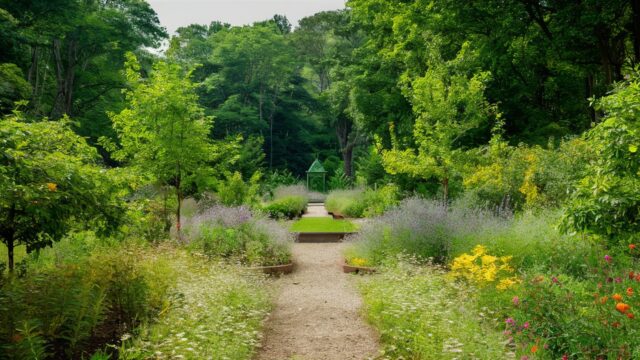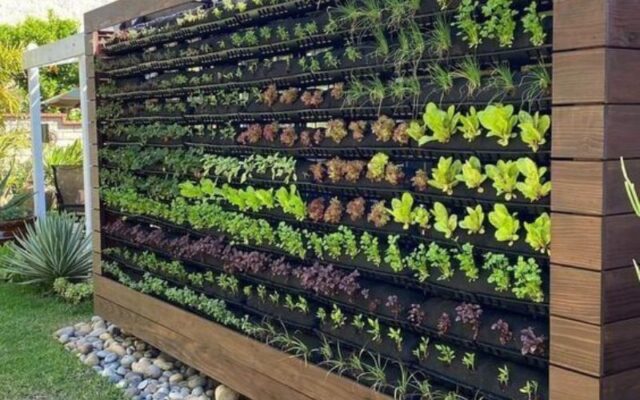
In an era where environmental consciousness is becoming more and more important, embracing sustainability in every aspect of our lives has become imperative. The garden, with its potential to be a haven of tranquillity and natural beauty, is an ideal space to implement eco-friendly practices.
From composting and water conservation to wildlife-friendly planting schemes, there are numerous ways to transform your outdoor space into a sustainable haven. In this article, we explore some of our favourite sustainable garden ideas, exploring how each one contributes to the preservation of our planet while enhancing the beauty of your outdoor sanctuary. Let’s take a look…
Composting for Soil Health

One of the fundamental principles of sustainable gardening is soil health. Composting is a simple yet effective way to enrich the soil with essential nutrients, reduce waste, and minimize reliance on chemical fertilizers. By composting kitchen scraps, garden waste, and even certain paper and cardboard products, you can create nutrient-rich mulch that improves soil structure and promotes healthy plant growth.
Encourage the decomposition process by turning the compost pile regularly and maintaining a balance of green and brown materials. Incorporating compost into your garden beds not only reduces landfill waste but also nurtures a thriving ecosystem beneath the surface.
Grow Your Own: Planting Vegetables
Embarking on growing your own vegetables in your garden is an enriching journey that offers numerous benefits, from fostering a deeper connection with nature to providing fresh, organic produce for your table.
To get started, begin by assessing your garden space, considering factors such as sunlight exposure, soil quality, and available water sources. Choose a spot that receives at least six hours of sunlight daily and has well-draining soil or consider raised beds or container gardening if your soil is poor.
Next, select vegetables suited to your climate and gardening experience level. Opt for easy-to-grow varieties like tomatoes, lettuce, peppers, and herbs for beginners. Research the specific needs of each vegetable regarding planting depth, spacing, and watering requirements. Prepare the soil by loosening it with a garden fork or tiller and adding organic matter such as compost or aged manure to enrich its fertility.
Water Conservation Techniques

Conserving water is paramount in sustainable garden practices, particularly in regions prone to drought. Implementing water-saving techniques such as mulching, drip irrigation, and rainwater harvesting can significantly reduce water consumption while sustaining lush greenery. Mulching not only helps retain moisture in the soil but also suppresses weed growth and adds organic matter as it decomposes.
Drip irrigation systems deliver water directly to the roots of plants, minimizing evaporation and runoff. Meanwhile, installing rain barrels or tanks allows you to collect and store rainwater for later use, reducing reliance on municipal water sources. These techniques not only conserve water but also promote the efficient use of this precious resource in your garden.
Wildlife-Friendly Planting
Creating a wildlife-friendly garden fosters biodiversity and supports local ecosystems. Choose native plants that provide food and habitat for birds, bees, butterflies, and other beneficial insects. Incorporate a variety of flowering plants to attract pollinators, such as lavender, buddleia, and echinacea. Include shrubs and trees that offer shelter and nesting sites, such as hawthorn, elderberry, and oak.
Avoid the use of pesticides and herbicides, which can harm beneficial pollinators and disrupt the natural balance of your garden. By nurturing a diverse array of plants, you can create a thriving ecosystem that sustains wildlife while adding beauty and vibrancy to your outdoor space.
Recycled Plastic Furniture: A Sustainable Choice
When it comes to outdoor furniture, opting for recycled plastic is a sustainable choice that helps reduce plastic pollution and minimizes the demand for single-use virgin plastic materials.
Recycled plastic furniture is made from unwanted plastic waste, such as bottles, containers, and packaging, which are shredded, melted down, cooled, and moulded into durable, weather-resistant pieces. Not only does this divert plastic from landfills, incinerators, and oceans, but it also prevents the extraction of raw materials and the energy-intensive production process associated with traditional plastic furniture.
Recycled plastic furniture is available in a range of styles and designs, from sleek modern chairs and benches to classic loungers, ensuring there’s something to suit every garden aesthetic. By investing in recycled plastic furniture, you can create a stylish and sustainable outdoor living space that aligns with your eco-friendly principles.
Native Plant Gardens
Native plant gardens are an excellent way to support local ecosystems while creating low-maintenance, sustainable landscapes. Native plants are adapted to the local climate, soil conditions, and wildlife, making them resilient and well-suited to thrive with minimal intervention.
By incorporating native species into your garden design, you can conserve water, reduce the need for fertilizers and pesticides, and attract a diverse array of wildlife. Choose a variety of plants with different bloom times to ensure year-round interest and provide food and habitat for pollinators and other beneficial insects.
Whether you’re creating a wildflower meadow, a woodland garden, or a coastal landscape, native plants offer beauty, biodiversity, and sustainability in equal measure.
Vertical Gardening Solutions

Maximizing vertical space is a clever way to increase growing area in small gardens while adding visual interest and architectural appeal. Vertical gardening solutions such as trellises, arbours, and living walls allow you to cultivate plants upwards, saving valuable ground space and creating a lush green backdrop.
Grow climbing plants like beans, peas, and cucumbers on trellises or support structures, freeing up space for other crops below. Create a living wall with cascading foliage plants or herbs, transforming a bare fence or wall into a verdant tapestry. Vertical gardens not only enhance the aesthetic appeal of your outdoor space but also promote air circulation, reduce soil erosion, and provide habitat for beneficial insects.
Conclusion
Transforming your garden into a sustainable space is both rewarding and essential in the fight against environmental degradation. By embracing composting, water conservation, wildlife-friendly planting, and other eco-friendly practices, you can create a vibrant outdoor sanctuary that nurtures both the soul and the planet.
Whether you’re revamping an existing garden or starting from scratch, incorporating sustainable principles into your design will not only enhance the beauty and functionality of your outdoor space but also contribute to a healthier, more resilient environment for generations to come.










